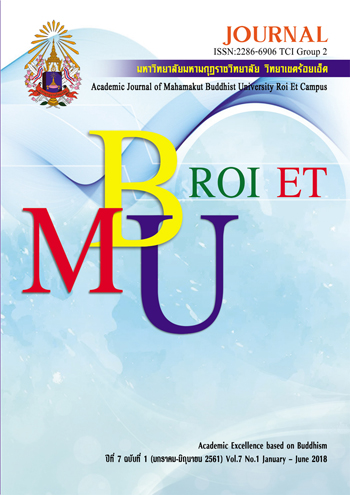Residents’ Participation in Drawing up Three-Year-Development Plans of Tambon Phanamyoi Administrative Organization in Nong Phok District, Roi Et Province
Main Article Content
Abstract
The purposes of this thematic paper were: 1) to study residents’ participation in drawing up three-year-development plans of Tambon Phanamyoi Administrative Organization in Nong Phok, Roi Et province, 2) compare their participation in drawing up its development plans to variables of their gender, ages and educational levels, and 3) to regulate suggestions for their participation in drawing up its development plans. The sampling group, based on Taro Yamane’s formula, comprised 326 people as the head of households or representatives from 13 villages in the aforesaid organization’s authorized area. The data collection instrument was five rating scale questionnaires of twenty questions, possessing the reliability for them at 0.90. The statistics exploited for data analyses encompassed percentage, mean and standard deviation, comparing differences in means by way of t-test and F-test (One-way ANOVA).
Outcomes of the research manifested the following findings: 1) Residents’ participation in drawing up three-year-development plans of Tambon Phanamyoi Administrative Organization in Nong Phok, Roi Et province was comprehensively rated ‘more’. Individually, four aspects were similarly scored. All aspects ranked in descending orders of means embraced those of: 1) participation in carrying out operations, 2) participation in decision-making, 3) participation in problematic proposals, and 4) participation in follow-up and assessment of its projects respectively. 2) The hypothesis testing results indicated that variables of residents’ genders showed significant differences in their participation in drawing up its development plans, thereby conforming to the reformulated hypotheses. By contrast, variables of their genders and educational levels proved otherwise, thus refusing the reformulated hypotheses. 3) Their suggestions for participation in drawing up its development plans were recommended in descending orders of three frequencies that the organization should: i) give people the opportunity to propose the problems of communities in the community arena increasingly, ii) give people the opportunity to participate in deciding the activities or project plan independently, iii) give people the public relations to participate in training program such as career training and saving group training, etc. held by the said organization.
Article Details
References
นรา ศรีวงษา. (2557). การมีส่วนร่วมของประชาชนในการจัดทำแผนพัฒนาองค์การบริหารส่วนตำบลโคกสว่าง อำเภอพนมไพร จังหวัดร้อยเอ็ด. การศึกษาค้นคว้าอิสระรัฐปรศาสนศาสตรมหาบัณฑิต. สาขาวิชานโยบายสาธารณะ. มหาวิทยาลัยมหาสารคาม.
นิภา ธาราโฉม. (2552). การมีส่วนร่วมของประชาชนในการจัดทำแผนพัฒนาเทศบาลตำบลบางนมโค อำเภอบางเสนา จังหวัดพระนครศรีอยุธยา. สารนิพนธ์ศาสนศาสตรมหาบัณฑิต. บัณฑิตวิทยาลัย : มหาวิทยาลัยมหามกุฏราชวิทยาลัย.
บุญชม ศรีสะอาด. (2545). การวิจัยเบื้องต้น. พิมพ์ครั้งที่ 6. กรุงเทพฯ : สุวีริยาสาส์น.
รจนา น้อยปลูก. (2557). การมีส่วนร่วมของประชาชนในการจัดทำแผนพัฒนาท้องถิ่นขององค์การบริหารส่วนตำบลแจ้ห่ม อำเภอแจ้ห่ม จังหวัดลำปาง. การค้นคว้าอิสระรัฐประศาสนศาสตรมหาบัณฑิต สาขาการบริหารท้องถิ่น. บัณฑิตวิทยาลัย : มหาวิทยาลัยเนชั่น.
วารุณี ศรีกระทุ่ม. (2556). การมีส่วนร่วมของประชาคมในการจัดทำแผนพัฒนาองค์การบริหารส่วนตำบลโพนสูง อำเภอปทุมรัตต์ จังหวัดร้อยเอ็ด. สารนิพนธ์ศาสนศาสตรมหาบัณฑิต. บัณฑิตวิทยาลัย : มหาวิทยาลัยมหามกุฏราชวิทยาลัย.
สำนักงานทะเบียนอำเภอหนองพอก. (2558). ข้อมูลสำมะโนประชากร. ร้อยเอ็ด : ที่ว่าการอำเภอหนองพอก. (อัดสำเนา).
องค์การบริหารส่วนตำบลผาน้ำย้อย. (2558). สภาพทั่วไปและข้อมูลขององค์การบริหารส่วนตำบลผาน้ำย้อย. ร้อยเอ็ด : องค์การบริหารส่วนตำบลผาน้ำย้อย. (อัดสำเนา).
อนุชาติ พวงสาลี และ วีรบูรณ์ วีสารทสกุล. (2541). ประชาสังคม : คำ ความคิด และความหมาย.กรุงเทพฯ : สถาบันชุมชนท้องถิ่นพัฒนา.


